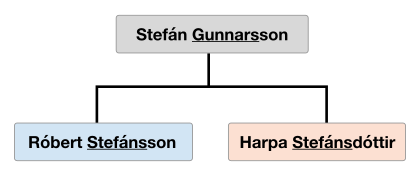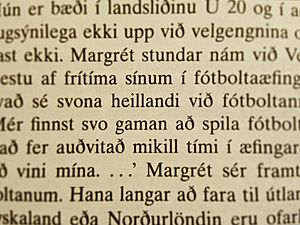Icelandic language facts for kids
Quick facts for kids Icelandic |
||||
|---|---|---|---|---|
| íslenska | ||||
| Native to | Iceland, Norway | |||
| Native speakers | 320,000 (2011) | |||
| Language family |
Indo-European
|
|||
| Writing system | Latin (Icelandic alphabet) Icelandic Braille |
|||
| Official status | ||||
| Official language in | ||||
| Regulated by | Árni Magnússon Institute for Icelandic Studies in an advisory capacity | |||
| Linguasphere | 52-AAA-aa | |||
|
||||
Icelandic is the language spoken by the people of Iceland.
It is a Germanic language. It comes from the Old Norse language, the language spoken by the Vikings. Because Iceland is far away from other countries, the language has not changed much. Icelandic people can still read words from hundreds of years ago.
Icelandic uses four characters that are not used in English: þ (thorn), (like 'th' in thin), ð (edh), (like 'th' in this), æ (pronounced like I) and ö (pronounced like the French U). It can also be said that ð is a "softer" version of þ.
Some linguists say there are only two Nordic languages, Eastern-Nordic and Western-Nordic, which includes Icelandic and Faroese because of their similarity.
Icelandic is also one of the most difficult languages to learn.
History
The oldest preserved texts in Icelandic were written around 1100 AD. Many of the texts are based on poetry and laws traditionally preserved orally. The most famous of the texts, which were written in Iceland from the 12th century onward, are the sagas of Icelanders, which encompass the historical works and the Poetic Edda.
The language of the sagas is Old Icelandic, a western dialect of Old Norse. The Dano-Norwegian, then later Danish rule of Iceland from 1536 to 1918 had little effect on the evolution of Icelandic (in contrast to the Norwegian language), which remained in daily use among the general population. Though more archaic than the other living Germanic languages, Icelandic changed markedly in pronunciation from the 12th to the 16th century, especially in vowels (in particular, á, æ, au, and y/ý).
The modern Icelandic alphabet has developed from a standard established in the 19th century, primarily by the Danish linguist Rasmus Rask. It is based strongly on an orthography laid out in the early 12th century by a document referred to as the First Grammatical Treatise by an anonymous author, who has later been referred to as the First Grammarian. The later Rasmus Rask standard was a re-creation of the old treatise, with some changes to fit concurrent Germanic conventions, such as the exclusive use of k rather than c. Various archaic features, as the letter ð, had not been used much in later centuries. Rask's standard constituted a major change in practice. Later 20th-century changes include the use of é instead of je and the replacement of z with s in 1973.
Apart from the addition of new vocabulary, written Icelandic has not changed substantially since the 11th century, when the first texts were written on vellum. Modern speakers can understand the original sagas and Eddas which were written about eight hundred years ago. The sagas are usually read with updated modern spelling and footnotes, but otherwise are intact (as with recent English editions of Shakespeare's works). With some effort, many Icelanders can also understand the original manuscripts.
Vocabulary

Early Icelandic vocabulary was largely Old Norse. The introduction of Christianity to Iceland in the 11th century brought with it a need to describe new religious concepts. The majority of new words were taken from other Scandinavian languages; kirkja ("church"), for example. Numerous other languages have influenced Icelandic: French brought many words related to the court and knightship; words in the semantic field of trade and commerce have been borrowed from Low German because of trade connections. In the late 18th century, language purism began to gain noticeable ground in Iceland and since the early 19th century it has been the linguistic policy of the country (see linguistic purism in Icelandic). Nowadays, it is common practice to coin new compound words from Icelandic derivatives.
Icelandic personal names are patronymic (and sometimes matronymic) in that they reflect the immediate father or mother of the child and not the historic family lineage. This system, which was formerly used throughout the Nordic area and beyond, differs from most Western systems of family name. In most Icelandic families, the ancient tradition of patronymics is still in use; i.e. a person uses their father's name (usually) or mother's name (increasingly in recent years) in the genitive form followed by the morpheme -son ("son") or -dóttir ("daughter") in lieu of family names.
Grammar
Icelandic retains many grammatical features of other ancient Germanic languages, and resembles Old Norwegian before much of its fusional inflection was lost. Modern Icelandic is still a heavily inflected language with four cases: nominative, accusative, dative and genitive. Icelandic nouns can have one of three grammatical genders: masculine, feminine or neuter. There are two main declension paradigms for each gender: strong and weak nouns, and these are further divided into subclasses of nouns, based primarily on the genitive singular and nominative plural endings of a particular noun. For example, within the strong masculine nouns, there is a subclass (class 1) that declines with -s (hests) in the genitive singular and -ar (hestar) in the nominative plural. However, there is another subclass (class 3) of strong masculine nouns that always declines with -ar (hlutar) in the genitive singular and -ir (hlutir) in the nominative plural. Additionally, Icelandic permits a quirky subject, that is, certain verbs have subjects in an oblique case (i.e. other than the nominative).
Nouns, adjectives and pronouns are declined in the four cases and for number in the singular and plural.
Verbs are conjugated for tense, mood, person, number and voice. There are three voices: active, passive and middle (or medial), but it may be debated whether the middle voice is a voice or simply an independent class of verbs of its own, as every middle-voice verb has an active-voice ancestor, but sometimes with drastically different meaning, and the middle-voice verbs form a conjugation group of their own. Examples are koma ("come") vs. komast ("get there"), drepa ("kill") vs. drepast ("perish ignominiously") and taka ("take") vs. takast ("manage to"). In each of these examples, the meaning has been so altered, that one can hardly see them as the same verb in different voices. Verbs have up to ten tenses, but Icelandic, like English, forms most of them with auxiliary verbs. There are three or four main groups of weak verbs in Icelandic, depending on whether one takes a historical or a formalistic view: -a, -i, and -ur, referring to the endings that these verbs take when conjugated in the first person singular present. Almost all Icelandic verbs have the ending -a in the infinitive, some with á, two with u (munu, skulu) one with o (þvo: "wash") and one with e (the Danish borrowing ske which is probably withdrawing its presence). Many transitive verbs (i.e. they require an object), can take a reflexive pronoun instead. The case of the pronoun depends on the case that the verb governs. As for further classification of verbs, Icelandic behaves much like other Germanic languages, with a main division between weak verbs and strong, and the strong verbs, of which there are about 150 to 200, are divided into six classes plus reduplicative verbs. They still make up some of the most frequently used verbs. (Að vera, "to be", is the example par excellence, having two subjunctives and two imperatives in addition to being made up of different stems.) There is also a class of auxiliary verbs, called the -ri verbs (4 or 5, depending who is counting) and then the oddity að valda ("to cause"), called the only totally irregular verb in Icelandic although every form of it is caused by common and regular sound changes.
The basic word order in Icelandic is subject–verb–object. However, as words are heavily inflected, the word order is fairly flexible, and every combination may occur in poetry.
Cognates with English
As Icelandic shares its ancestry with English and both are Germanic languages, there are many cognate words in both languages; each have the same or a similar meaning and are derived from a common root. The possessive, though not the plural, of a noun is often signified with the ending -s, as in English. Phonological and orthographical changes in each of the languages will have changed spelling and pronunciation. A few examples are given below.
| English word | Icelandic word | Spoken comparison |
|---|---|---|
| apple | epli | |
| book | bók | |
| high/hair | hár | |
| house | hús | |
| mother | móðir | |
| night | nótt/nátt | |
| stone | steinn | |
| that | það | |
| word | orð |
See also
 In Spanish: Idioma islandés para niños
In Spanish: Idioma islandés para niños




